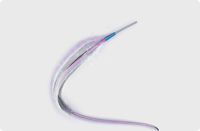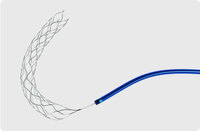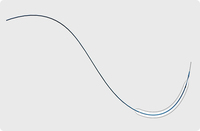Peripheral Vascular Treatment
Product Quick Detail
- FOB Price
- USD $45.00 / Piece
- Minimum Order
- 10
- Place Of Origin
- Zhejiang Province, P.R.China
- Packaging
- N/A
- Delivery
- 2-12 weeks
Specifications
Peripheral Vascular Treatment
What Is Peripheral Vascular Disease?
Peripheral Vascular Disease (PVD) refers to conditions that affect blood vessels outside the heart and cerebral arteries. It is commonly caused by atherosclerosis, blood clots, or inflammation,
reducing blood flow and potential complications. Early detection and treatment are crucial to prevent serious consequences.
Peripheral Vascular Disease Symptoms
Peripheral vascular disease (PVD) symptoms may include leg pain, cramping, fatigue, and difficulty walking. Early signs might be subtle, but as the disease progresses, it can lead to more severe
complications. Prompt recognition and medical attention are essential to manage PVD effectively.
1. Leg pain or cramping, especially during physical activity (intermittent claudication).
2. Numbness or weakness in the legs.
3. Coldness or paleness of the legs or feet.
4. Hair loss or slow hair growth on the legs.
5. Slow-healing sores or wounds on the legs or feet.
6. Changes in skin colour or shiny skin on the legs.
7. Weak or no pulse in the legs or feet.
8. Erectile dysfunction in men.
Peripheral Intervention Meaning
Peripheral Vascular Disease (PVD) affects blood vessels outside the heart and cerebral arteries, causing various symptoms like leg pain, cramping, and reduced blood flow. In the realm of peripheral
vascular treatment, Peripheral Interventions play a pivotal role.
1. Medications: Antiplatelet agents, Cholesterol-lowering medications, Vasodilators, Blood pressure medications.
2. Peripheral Interventions: Peripheral Interventions, also known as endovascular procedures, are minimally invasive treatments that can significantly improve blood flow and alleviate PVD symptoms.
Some commonly performed peripheral vascular interventions include:
Angioplasty: A balloon is inserted into the narrowed artery and inflated to widen the vessel, restoring blood flow.
Stent placement: A metal mesh catheter is inserted to keep the artery open, preventing future blockages.
Atherectomy: Plaque is removed from the artery to enhance blood flow.
3. Surgical Interventions: In more severe cases of PVD, surgical procedures may be necessary. Common surgical interventions include:
Bypass surgery: A healthy blood vessel is used to reroute blood around a blocked artery, restoring blood flow to the affected area.
Endarterectomy: The inner lining of the artery is surgically cleaned to remove plaque buildup, improving blood flow.
Amputation: In extreme cases of tissue damage or infection, amputation may be required to prevent further complications.
Peripheral Vascular Devices
Drug Coated PTA Balloon Catheter: The UltraFree™ drug-eluting PTA balloon dilation catheter uses pure paclitaxel drug coating design, relying on patented drug coating spraying technology, breaks
through the amorphous form of pure paclitaxel crystals to achieve efficient transportation, dispersion and slow release of paclitaxel drug particles.
ZENFLEX® Pro Peripheral Drug-eluting Stent System: ZENFLEX® Pro Peripheral Drug-eluting Stent System is a paclitaxel drug stent designed based on ZENFLEX Peripheral stent platform and polymer-free
coating.
Peripheral Stent System: ZENFLEX Peripheral Stent is a laser-cutting nitinol self-expanding stent. Its superior performance is assured by optimal helical stent design combined with micromesh
design.
PTA Balloon Catheter: ZENFLOW®-35 Peripheral Balloon Dilation Catheter adopts new balloon material and super-smooth coating, combined with a soft tapered tip design, which enables the balloon to
obtain excellent passability, and becomes the main working balloon for the wide application of peripheral vascular intervention.
ZENFLOW®-18 PTA balloon dilator catheter uses a new balloon material and super-smooth coating, combined with a soft tapered head design, to achieve excellent penetration of the balloon, making it a
high-performance balloon to meet the needs of the treatment of difficult lower limb artery diseases.
ZENFLOW®-14 PTA balloon dilator uses a new balloon material and super-smooth coating, combined with a soft tapered head design, to achieve excellent penetration of the balloon and meet the needs of
the treatment of challenging BTK vascular diseases.
High-Pressure PTA Balloon Catheter: The ZENFLOW® HP PTA high-pressure balloon dilation catheter is made of double compound balloon material and can burst pressure up to 24 atm. Excellent
non-compliance and passability, providing stronger expansion tension to ensure arteriovenous patency.
Providing professional solutions for both neuro interventions and peripheral vascular interventions, Zylox-Tonbridge can provide you with the right peripheral intervention devices with consistently
high quality. Feel free to contact us at any time.
For more information about peripheral intervention procedure, please feel free to contact us!
Zylox medical is a leading player in the peripheral and neurovascular interventional medical device market in China. As a fully integrated medical device company, we have strong R&D and
manufacturing capabilities, multiple specialized technology platforms, and proven commercialization capabilities.
- Country: China (Mainland)
- Founded Year: 2012
- Contact: Zylox com










